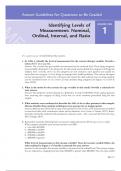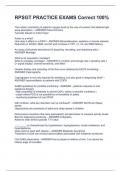Answer Guidelines for Questions to Be Graded
EX ERCIS E
Identifying Levels of
Measurement: Nominal,
Ordinal, Interval, and Ratio
1
M
ED
The questions are in bold followed by answers.
C
1. In Table 1, identify the level of measurement for the current therapy variable. Provide a
rationale for your answer.
Answer: The current therapy variable was measured at the nominal level. These drug categories
O
were probably developed to be exhaustive for this study and included the categories of drugs the
subjects were receiving. However, the categories are not exclusive, since patients are usually on
more than one category of these drugs to manage their health problems. The current therapies
are not measured at the ordinal level because they cannot be rank ordered, since no drug category
N
can be considered more or less beneficial than another drug category (see Figure 1-1; Grove &
Gray, 2019).
N
2. What is the mode for the current therapy variable in this study? Provide a rationale for
your answer.
Answer: The mode for current therapy was  blocker. A total of 100 (94%) of the cardiac patients
O
were receiving this category of drug, which was the most common prescribed drug for this
sample.
IS
3. What statistics were conducted to describe the BMI of the cardiac patients in this sample?
Discuss whether these analysis techniques were appropriate or inappropriate.
Answer: BMI was described with a mean and standard deviation (SD). BMI measurement resulted
in ratio-level data with continuous values and an absolute zero (Stone & Frazier, 2017). Ratio-
level data should be analyzed with parametric statistics such as the mean and SD (Grove & Gray,
SE
2017; Knapp, 2017).
4. Researchers used the following item to measure registered nurses’ (RNs) income in a study:
What category identifies your current income as an RN?
a. Less than $50,000
U
b. $50,000 to 59,999
c. $60,000 to 69,999
d. $70,000 to 80,000
e. $80,000 or greater
R
What level of measurement is this income variable? Does the income variable follow the
rules outlined in Figure 1-1? Provide a rationale for your answer.
Answer: In this example, the income variable is measured at the ordinal level. The income catego-
ries are exhaustive, ranging from less than $50,000 to greater than $80,000. The two open-ended
AG 1-1
, AG 1-2 Answer Guidelines for Questions to Be Graded
categories ensure that all salary levels are covered. The categories are not exclusive, since catego-
ries (d) and (e) include an $80,000 salary, so study participants making $80,000 might mark
either (d) or (e) or both categories, resulting in erroneous data. Category (e) could be changed
to greater than $80,000, making the categories exclusive. The categories can be rank ordered
from the lowest salary to the highest salary, which is consistent with ordinal data (Grove &
Gray, 2019; Waltz et al., 2017).
M
5. What level of measurement is the CDS score? Provide a rationale for your answer.
Answer: The CDS score is at the interval level of measurement. The CDS is a 26-item Likert
ED
scale developed to measure depression in cardiac patients. Study participants rated their symp-
toms on a scale of 1 to 7, with higher numbers indicating increased severity in the depression
symptoms. The total scores for each subject obtained from this multi-item scale are considered
to be at the interval level of measurement (Gray et al., 2017; Waltz et al., 2017).
6. Were nonparametric or parametric analysis techniques used to analyze the CDS scores for
C
the cardiac patients in this study? Provide a rationale for your answer.
Answer: Parametric statistics, such as mean and SD, were conducted to describe CDS scores
for study participants (see Table 1). CDS scores are interval-level data as indicated in Questions 5,
O
so parametric statistics are appropriate for this level of data (Gray et al., 2017; Kim & Mallory,
2017).
7. Is the prevalence of depression linked to the NYHA class? Discuss the clinical importance
N
of this result.
Answer: The study narrative indicated that the prevalence of depression increased with the
greater NYHA class. In NYHA class III, 64% of the subjects were depressed, whereas 11% of the
N
subjects were depressed in NYHA class I. Thus, as the NYHA class increased, the number of sub-
jects with depression increased. This is an expected finding because as the NYHA class increases,
cardiac patients have more severe physical symptoms, which usually result in emotional distress,
O
such as depression. Nurses need to actively assess cardiac patients for depression, especially those
in higher NYHA classes, so they might be diagnosed and treated as needed.
IS
8. What frequency and percent of cardiac patients in this study were not being treated with
an antidepressant? Show your calculations and round your answer to the nearest whole
percent (%).
Answer: A total of 106 cardiac patients participated in this study. The sample included
15 patients who were receiving an antidepressant (see Table 1). The number of cardiac
SE
patients not treated for depression was 91 (106 – 15 ⫽ 91). The group percent is calculated
by the following formula: (group frequency ⫼ total sample size) ⫻ 100%. For this study,
(91 patients ⫼ 106 sample size) ⫻ 100% ⫽ 0.858 ⫻ 100% ⫽ 85.8% ⫽ 86%. The final
answer is rounded to the nearest whole percent as directed in the question. You could have
also subtracted the 14% of patients treated with antidepressants from 100% and obtained the
U
86% who were not treated with an antidepressant.
9. What was the purpose of the 6-minute walk test (6MWT)? Would the 6MWT be useful in
clinical practice?
R
Answer: Ha et al. (2018) stated, “The 6-min walk test (6MWT) is a measure of the submaximal,
steady-state functional capacity” of cardiac patients. This test would be a quick, easy way to
determine a cardiac patient’s functional status in a clinical setting. This functional status
score could be used to determine the treatment plan to promote or maintain functional status
of cardiac patients.
, Answer Guidelines for Questions to Be Graded AG 1-3
10. How was exercise confidence measured in this study? What was the level of measurement
for the exercise confidence variable in this study? Provide a rationale for your answer.
Answer: Exercise confidence of the patients with heart failure (HF) in this study was measured
with the Exercise Confidence Scale that included four subscales focused on walking, climbing,
lifting objects of graded weight, and running (see the study narrative). This was a rating scale
with values ranging from 0 to 100. The patients’ scores for the Total Exercise Confidence scale
M
and the subscales were considered interval-level data and analyzed with parametric statistics,
such as means and SDs (see the study narrative; Waltz et al., 2017).
ED
C
O
N
N
O
IS
SE
U
R
, Exercise 2: Identifying Probability and Nonprobability Sampling Methods in Studies
1. Probability, simple random sampling. Each department was in the target was identified by a
number that had been selected from a random numbers table.
2. Yes, the sample is representative. Probability sampling allows every person or element of the
M
study population to be represented without researcher bias and minimizes sampling error.
3. Nonprobability, convenience sampling. In convenience sampling, subjects are enrolled in the
study until the target sample size is reached. Convenience sampling does not allow for the
ED
opportunity to control for sampling errors and biases.
4. Nonprobability, network or snowball sampling. Network or snowball sampling makes use of
social networks and the fact that friends often have common characteristics. The selected
individuals were asked to locate other substance abusers they knew to participate in the study.
5. Probability; stratified random sampling. Stratified random sampling is used when the
researcher knows some of the variables within a population that will affect the representatives of
C
the sample.
m
er as
6. Was the sample identified in the Ulrich et al. (2005) study in Question 5 representative of the
target population of NPs and PAs? Provide a rationale for your answer.
O
co
eH w
Yes, stratified random sampling is used when some of the variables within a population are
known that will affect the representativeness of the sample.
o.
7. Nonprobability; purposive sampling. Purposive sampling occurs when the researcher
rs e
N
consciously selects subjects, elements, events, or incidents to include in the study. The event in
ou urc
this study is the tornado. Those selected for the study lived in the city where the tornado
occurred.
N
8. Nonprobability; convenience sampling. Participants in convenience sampling are recruited
o
because they are accessible and available to participate. The participants of this study were
aC s
chosen because they were admitted to the hospital.
vi y re
O
9. Nonprobability; purposive sampling then theoretical sampling. Purposive sampling was used
because the participants were selected based on their familiarity with, interest in, and willingness
to reflect and discuss their hope experience. Theoretical sampling was then used to achieve
IS
theoretical saturation.
ed d
10. Nonprobability; purposive sampling. Purposive sampling was used because the researcher
ar stu
consciously selected the subjects.
SE
Exercise 3: Understanding the Sampling Section of a Research Report: Population,
is
Sampling Criteria, Sample Size, Refusal Rate, and Attrition Rate
1. Did the study include sampling inclusion criteria? What were those criteria? Were these
Th
criteria appropriate for this study?
Yes
U
The criteria were children aged 3 to 5 years, mother had primary or regular visitation of
child, the dyad lived in state or were able to meet in state for the data collection, the
sh
mother participated in the MTB program or the control condition beyond the initial
R
consent period
Yes, the criteria is appropriate for the study.
2. Sampling inclusion and exclusion are developed to determine what type of population? What
is the accessible population? Document your answer.





